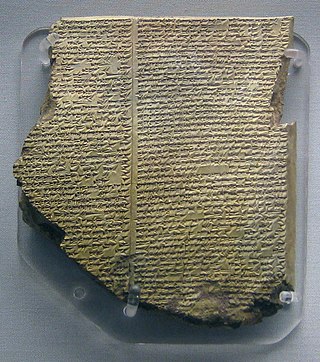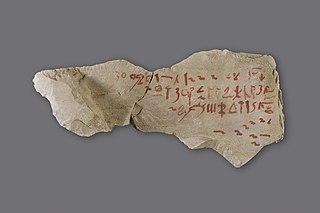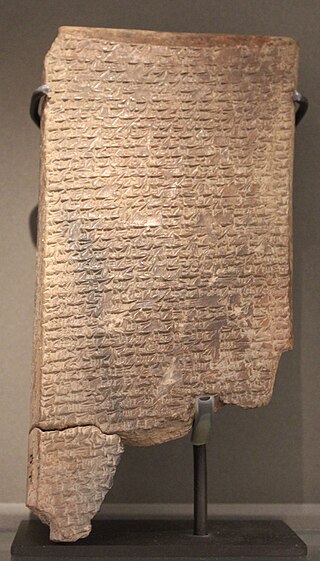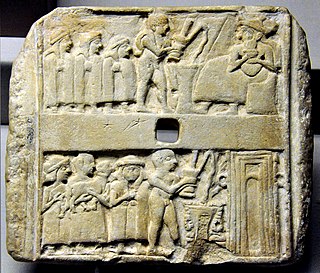Related Research Articles
The Book of Habakkuk is the eighth book of the 12 minor prophets of the Bible. It is attributed to the prophet Habakkuk, and was probably composed in the late 7th century BC. The original text was written in Hebrew language.
Akkadian literature is the ancient literature written in the Akkadian language in Mesopotamia during the period spanning the Middle Bronze Age to the Iron Age.

The Epic of Gilgamesh is an epic poem from ancient Mesopotamia. The literary history of Gilgamesh begins with five Sumerian poems about Bilgamesh, king of Uruk, dating from the Third Dynasty of Ur. These independent stories were later used as source material for a combined epic in Akkadian. The first surviving version of this combined epic, known as the "Old Babylonian" version, dates back to the 18th century BC and is titled after its incipit, Shūtur eli sharrī. Only a few tablets of it have survived. The later Standard Babylonian version compiled by Sîn-lēqi-unninni dates from the 13th to the 10th centuries BC and bears the incipit Sha naqba īmuru. Approximately two-thirds of this longer, twelve-tablet version have been recovered. Some of the best copies were discovered in the library ruins of the 7th-century BC Assyrian king Ashurbanipal.

In Akkadian mythology the Rabisu, or possibly Rabasa, are vampiric spirits, daimons, or demons. The Rabisu are associated in mythology with the Curse of Akkad. A consistent translation of "Rabisu" is “Lingerers”. The Rabisu, whether intending malicious actions or not, linger around those who have been found wayward or to be rewarded by the deity Enlil.

Exegesis is a critical explanation or interpretation of a text. The term is traditionally applied to the interpretation of Biblical works. In modern usage, exegesis can involve critical interpretations of virtually any text, including not just religious texts but also philosophy, literature, or virtually any other genre of writing. The phrase Biblical exegesis can be used to distinguish studies of the Bible from other critical textual explanations.
Siduri, or more accurately Šiduri (Shiduri), is a character in the Epic of Gilgamesh. She is described as an alewife. The oldest preserved version of the composition to contain the episode involving her leaves her nameless, and in the later standard edition compiled by Sîn-lēqi-unninni her name only appears in a single line. She is named Naḫmazulel or Naḫmizulen in the preserved fragments of Hurrian and Hittite translations. It has been proposed that her name in the standard edition is derived from an epithet applied to her by the Hurrian translator, šiduri, "young woman." An alternate proposal instead connects it with the Akkadian personal name Šī-dūrī, "she is my protection." In all versions of the myth in which she appears, she offers advice to the hero, but the exact contents of the passage vary. Possible existence of Biblical and Greek reflections of the Šiduri passage is a subject of scholarly debate.

Wisdom literature is a genre of literature common in the ancient Near East. It consists of statements by sages and the wise that offer teachings about divinity and virtue. Although this genre uses techniques of traditional oral storytelling, it was disseminated in written form.

Nebuchadnezzar I or Nebuchadrezzar I, reigned c. 1121–1100 BC, was the fourth king of the Second Dynasty of Isin and Fourth Dynasty of Babylon. He ruled for 22 years according to the Babylonian King List C, and was the most prominent monarch of this dynasty. He is best known for his victory over Elam and the recovery of the cultic idol of Marduk.

Matthew 5:44, the forty-fourth verse in the fifth chapter of the Gospel of Matthew in the New Testament, also found in Luke 6:27–36, is part of the Sermon on the Mount. This is the second verse of the final antithesis, that on the commandment to "Love thy neighbour as thyself". In the chapter, Jesus refutes the teaching of some that one should "hate [one's] enemies".

Instruction of Amenemope is a literary work composed in Ancient Egypt, most likely during the Ramesside Period ; it contains thirty chapters of advice for successful living, ostensibly written by the scribe Amenemope son of Kanakht as a legacy for his son. A characteristic product of the New Kingdom "Age of Personal Piety", the work reflects on the inner qualities, attitudes, and behaviors required for a happy life in the face of increasingly difficult social and economic circumstances. It is widely regarded as one of the masterpieces of ancient near-eastern wisdom literature and has been of particular interest to modern scholars because of its similarity to the later biblical Book of Proverbs.
Ancient Near Eastern Texts Relating to the Old Testament edited by James B. Pritchard is an anthology of important historical, legal, mythological, liturgical, and secular texts in biblical archaeology.

Sumerian literature constitutes the earliest known corpus of recorded literature, including the religious writings and other traditional stories maintained by the Sumerian civilization and largely preserved by the later Akkadian and Babylonian empires. These records were written in the Sumerian language in the 18th and 17th centuries BC during the Middle Bronze Age.

Ludlul bēl nēmeqi, also sometimes known in English as The Poem of the Righteous Sufferer, is a Mesopotamian poem written in Akkadian that concerns itself with the problem of the unjust suffering of an afflicted man, named Šubši-mašrâ-Šakkan (Shubshi-meshre-Shakkan). The author is tormented, but he does not know why. He has been faithful in all of his duties to the gods. He speculates that perhaps what is good to man is evil to the gods and vice versa. He is ultimately delivered from his sufferings. It is thought to have been composed during the reign of Kassite king of Babylon Nazi-Maruttaš, who is mentioned on line 105 of tablet IV.
The earliest record of a Sumerian creation myth, called The Eridu Genesis by historian Thorkild Jacobsen, is found on a single fragmentary tablet excavated in Nippur by the Expedition of the University of Pennsylvania in 1893, and first recognized by Arno Poebel in 1912. It is written in the Sumerian language and dated to around 1600 BCE. Other Sumerian creation myths from around this date are called the Barton Cylinder, the Debate between sheep and grain and the Debate between Winter and Summer, also found at Nippur.

The Instructions of Shuruppak are a significant example of Sumerian wisdom literature. Wisdom literature, intended to teach proper piety, inculcate virtue, and preserve community standards, was common throughout the ancient Near East. Its incipit sets the text in great antiquity by : "In those days, in those far remote times, in those nights, in those faraway nights, in those years, in those far remote years." The precepts are placed in the mouth of a king Šuruppak (SU.KUR.RUki), son of Ubara-Tutu. Ubara-Tutu is recorded in most extant copies of the Sumerian king list as being the final king of Sumer prior to the deluge. Ubara-tutu is briefly mentioned in tablet XI of the Epic of Gilgamesh, where he is identified as the father of Utnapishtim, a character who is instructed by the god Ea to build a boat in order to survive the coming flood. Grouped with the other cuneiform tablets from Abu Salabikh, the Instructions date to the early third millennium BCE, being among the oldest surviving literature.

Sumerian religion was the religion practiced by the people of Sumer, the first literate civilization of ancient Mesopotamia. The Sumerians regarded their divinities as responsible for all matters pertaining to the natural and social orders.
The Dialogue of Pessimism is an ancient Mesopotamian literary composition in the form of a dialogue between a master and his slave. Its interpretations have varied, but it is generally considered an unusual text which thematises the futility of human action. It is an example of ancient Near Eastern wisdom literature.
Zisurrû, meaning “magic circle drawn with flour,” and inscribed ZÌ-SUR-RA-a, was an ancient Mesopotamian means of delineating, purifying and protecting from evil by the enclosing of a ritual space in a circle of flour. It involved ritual drawings with a variety of powdered cereals to counter different threats and is accompanied by the gloss: SAG.BA SAG.BA, Akkadian: māmīt māmīt, the curse from a broken oath, in The Exorcists Manual, where it refers to a specific ritual on two tablets the first of which is extant.

The Dialogue between a Man and His God is the earliest known text to address the answer to the question of why a god permits evil, or theodicy, a reflection on human suffering. It is a piece of Wisdom Literature extant on a single clay cuneiform tablet written in Akkadian and attributed to Kalbanum, on the last line, an individual otherwise unknown. It is dated to the latter part of the Old Babylonian period, around about the reign of Ammi-Ditana according to Lambert, and is currently housed in the Louvre Museum, accession number AO 4462. It is of unknown provenance as it was purchased from an antiquities dealer by the Museum in 1906. It shares much of its style with an earlier Sumerian work, “Man and His God”, a penitential prayer of the UR III period.
References
- Barré, Michael L. (1981). ""Fear of God" and the World View of Wisdom". Biblical Theology Bulletin . SAGE Publications. 11 (2): 41–43. doi:10.1177/014610798101100203. S2CID 170183050.
- Kitchen, Kenneth A. (1977). "Proverbs and wisdom books of the ancient Near East: the factual history of a literary form" (PDF). Tyndale Bulletin . 28: 69–114. doi:10.53751/001c.30617. Archived from the original (PDF) on 18 May 2012. Retrieved 16 April 2017.
- Lambert, Wilfred G. (1996). Babylonian Wisdom Literature. Eisenbrauns. p. 96–107. ISBN 978-0-931464-94-2 . Retrieved 16 April 2017.
